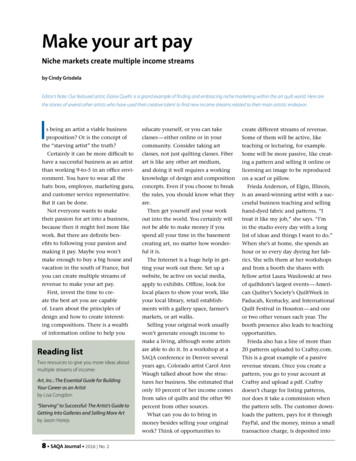
Transcription
Make your art payNiche markets create multiple income streamsby Cindy GrisdelaEditor’s Note: Our featured artist, Elaine Quehl. is a grand example of finding and embracing niche marketing within the art quilt world. Here arethe stories of several other artists who have used their creative talent to find new income streams related to their main artistic endeavor.Is being an artist a viable businesseducate yourself, or you can takecreate different streams of revenue.proposition? Or is the concept ofclasses — either online or in yourSome of them will be active, likecommunity. Consider taking artteaching or lecturing, for example.classes, not just quilting classes. FiberSome will be more passive, like creat-have a successful business as an artistart is like any other art medium,ing a pattern and selling it online orthan working 9-to-5 in an office envi-and doing it well requires a workinglicensing an image to be reproducedronment. You have to wear all theknowledge of design and compositionon a scarf or pillow.hats: boss, employee, marketing guru,concepts. Even if you choose to breakFrieda Anderson, of Elgin, Illinois,and customer service representative.the rules, you should know what theyis an award-winning artist with a suc-But it can be done.are.cessful business teaching and sellingthe “starving artist” the truth?Certainly it can be more difficult toNot everyone wants to makeThen get yourself and your workhand-dyed fabric and patterns. “Itheir passion for art into a business,out into the world. You certainly willtreat it like my job,” she says. “I’mbecause then it might feel more likenot be able to make money if youin the studio every day with a longwork. But there are definite ben-spend all your time in the basementlist of ideas and things I want to do.”efits to following your passion andcreating art, no matter how wonder-When she’s at home, she spends anmaking it pay. Maybe you won’tful it is.hour or so every day dyeing her fab-make enough to buy a big house andThe Internet is a huge help in get-rics. She sells them at her workshopsvacation in the south of France, butting your work out there. Set up aand from a booth she shares withyou can create multiple streams ofwebsite, be active on social media,fellow artist Laura Wasilowski at tworevenue to make your art pay.apply to exhibits. Offline, look forof quiltdom’s largest events — Ameri-First, invest the time to cre-local places to show your work, likecan Quilter’s Society’s QuiltWeek inate the best art you are capableyour local library, retail establish-Paducah, Kentucky, and Internationalof. Learn about the principles ofments with a gallery space, farmer’sQuilt Festival in Houston — and onedesign and how to create interest-markets, or art walks.or two other venues each year. Theing compositions. There is a wealthof information online to help youSelling your original work usuallywon’t generate enough income tomake a living, although some artistsbooth presence also leads to teachingopportunities.Frieda also has a line of more thanReading listare able to do it. In a workshop at a20 patterns uploaded to Craftsy.com.Two resources to give you more ideas aboutmultiple streams of income:SAQA conference in Denver severalThis is a great example of a passiveyears ago, Colorado artist Carol Annrevenue stream. Once you create aWaugh talked about how she struc-pattern, you go to your account atArt, Inc.: The Essential Guide for BuildingYour Career as an Artistby Lisa Congdontures her business. She estimated thatCraftsy and upload a pdf. Craftsyonly 10 percent of her income comesdoesn’t charge for listing patterns,from sales of quilts and the other 90nor does it take a commission when“Starving” to Successful: The Artist’s Guide toGetting Into Galleries and Selling More Artby Jason Horejspercent from other sources.the pattern sells. The customer down-8 SAQA Journal 2016 No. 2What can you do to bring inloads the pattern, pays for it throughmoney besides selling your originalPayPal, and the money, minus a smallwork? Think of opportunities totransaction charge, is deposited into
Floris Flam sells herhand-dyed socks andother items through herco-op gallery and variouslocal and regional shows.your account. There is little workeverything with professionalism, evenThere are a number of avenues toinvolved after the pattern is createdif it’s a free presentation to a group ofcreate income out there, but look forand uploaded, except for whateverthird graders,” Ellen advises.those that you would enjoy doing.you decide to do to send potentialcustomers to the site.Bethesda, Maryland, artist FlorisWhen Ellen was transitioning herFlam hand dyes her own fabrics forquilt hobby into a business, shethe original art quilts she makes.didn’t know which revenue streamLindner also teaches, both in personWhile she’s dyeing the fabric, she alsomight work best, so she pursued all ofand online. She sells patterns anddyes other items, such as bamboothem: selling via her website and gal-writes articles for publications. Hersocks and cloth napkins. She sellsleries, teaching, and writing articles.advice for artists wanting to expandthem at various local and regionalShe soon found that teaching was theinto alternative revenue streams is:shows she attends each year. Florisbest option for her and she focused“Jump in and try it!”belongs to a co-op fiber art galleryon that, while also realizing that gal-Melbourne, Florida, artist Ellen“Many options require no financialat the Torpedo Factory Art Centerlery representation was not right foroutput. Remember, too, that every-in Alexandria, Virginia. When sheher at that time.thing supports everything else. If youjoined the gallery in 2002, she madehave a quilt hanging in a prestigiousart quilts and wearable vests. Theshe sells, Floris noted, “The smallfine art show, it may not seem like itvests didn’t sell well enough to makestuff I don’t do if I don’t enjoy it.”helps you sell patterns, but it does.them worthwhile, so she transitionedShe likes dyeing and playing withThe prestige and publicity you gainout of those and into smaller itemscolor, so dyeing socks and napkins isfrom the former help with the latterthat could make nice gifts, like busi-a logical extension of what she doesand vice versa. If you’re marketingness card cases, silk scarves, and fabricanyway.patterns, you are also putting your-bowls. “Card cases are my best seller,”self in the public eye and exposingshe says.yourself to other opportunities. DoTalking about the smaller gift itemsDebra Jones, a portrait artist fromScottsdale, Arizona, pursues two otherniche markets with her painting. InSAQA Journal 2016 No. 2 9
Watercolor artist Debra Jones expanded her business by adding commissioned petportraits to her offerings.addition to portraits of people, sheor boxes in odd moments when sheinitial idea doesn’t work out the waypaints pets. Pet commissions are onehas free time.she envisioned.way she has expanded her business,The cards have led to sales ofEllen does business activities in heras some clients would pay for a paint-original work when customers see anhome office and creates her work ining of a beloved pet instead of, or inimage they like and ask if the originalher studio. She estimates that aboutaddition to, one of themselves.is available. If the original has been60 percent of her time is devoted tosold, sometimes the card will lead tobusiness and teaching pursuits, witha commission of a similar subject.only 40 percent being active studioDebra also paints generic animalswhich she sells through a print-ondemand site called Fine Art America.One question many artists withAfter completing a painting of a run-multiple streams of income wrestlening Yorkie, for example, she photo-with is how to balance their timewaking hours thinking of opportuni-graphs the painting and uploads it tobetween creating original work andties. She doesn’t do much teaching,the site. They print, frame, and senddoing the work that brings in regularbut she’s often asked to donate workthe image to the customer and giveincome. Some, like Floris, work into charitable organizations for auc-Jones an agreed-upon percentage ofspurts when the need arises. “If I havetion. She always sets a reserve pricethe sale.a show coming up, I might do threeas a floor for the bidding, and shedozen socks and three dozen sets ofasks to be present at the event so shenapkins, plus card cases,” she says.can do demonstrations and talk toLinda Jones (no relation to Debra)is a watercolor and acrylic painter inMcLean, Virginia. She supplementsFrieda dyes every day she is attime.Debra says she spends all of herattendees to educate people about herher income from original art byhome so she maintains a regularprocess. “I need to explain to peopleteaching and also by making note-inventory. It can take three years towhy I am a necessity,” she says.cards from her favorite paintings. Shecreate a large original quilt, workingsells the cards both individually andon it a little bit at a time. When shecome your way and say “yes” if youin boxed sets. She photographs thehas breaks from her teaching andcan. “I weigh every opportunity andpainting immediately after finish-show schedule, she takes time tosee where it leads me,” Debra says.ing it and uploads the image to herdevote her full attention to her art.computer. She formats and prints theShe gives herself room not only tocards herself and puts them togetherwork, but also for failure in case thewith envelopes in cellophane sleeves10 SAQA Journal 2016 No. 2Be open to opportunities that mayCindy Grisdela is a SAQA JAM livingin Reston, Virginia. See her work atcindygrisdela.com.
Teaching: Part 1 in a seriesFor love or moneyTips to build a career as a teacher on the goby Lyric Montgomery KinardAtraveling quilt teacher enjoys a soul-feedingthe skill and experience to help students overcomeprofession. To join this collegial club, plandifficulties. You also have to have the ability toyour approach so you streamline the process andthink ahead about each student’s progress and helpavoid pitfalls. In this first of two articles on the sub-them avoid stumbling blocks.ject, I’ll explore motivation, potential class offerings, and practical tips to navigate the field.to share your ideas. Students are there to learnThere are as many reasons to teach as there arefrom you. The very best teachers don’t hold backteachers. Four main reasons are: earning income,information. Copyright covers your publications,enjoying travel, meeting new people, and sharingbut it’s a good idea to gently remind students thatyour knowledge. Understanding your motivationit is unethical to copy and share your handoutslets you develop your style. Here is a rundown ofand patterns. There are easy ways to protect youreach factor and tips to consider.publications, such as watermarking handouts orMoney matterspatterns.Think honestly about how you best interactDo you need the money? Teaching is not one ofwith people. If you are an extrovert, developthe better-paying professions. For every day youentertaining lectures and work with structuredteach, you spend many days running your busi-group activities. If you are an introvert, you mayness. If you need to support yourself, learn tofocus on courses that provide individual attention.maximize your profits and still offer a wonderfulBoth personalities make wonderful teachers, andexperience. You will need to gain serious marketingboth will need to be patient with a wide varietyskills plus have the stamina and organization toof people. Talk to other quilt teachers. When theyregularly work back-to-back gigs.share their “most difficult student ever” story, askIf teaching will be a pleasant side hustle, youhow they handled the scenario. Also, watch teach-may be more concerned with guarding your time.ers in action. Put yourself in situations where youEstimate how much time you want to devote andmust diplomatically help someone with a difficultknow your limits. Many teachers overbook them-personality.selves, get burnt out, but still have obligationsKnow that a teacher is always “on.” You are edu-a year or two into the future. Also, make sure tocating and entertaining. Students expect you to bereserve time for family events as well as to createas wonderful, enthusiastic, and generous in the hallyour own work.as you are in class. I include a note in my hostessCaring to share24Remember, the primary goal of teaching isinstructions that I need to be in my room aloneby a certain hour so I can wind down and rest.If you want to share, evaluate your technical skillNobody has ever been offended by this request,level. You don’t have to be perfect, but you needand it has allowed for graceful retreats. SAQA Journal 2018 No. 4
If you love teaching projects, do you haveDo you love to travel? Can you manage long drivesor dragging luggage through multiple airports?Your physical strength and stamina may determinethe supplies you bring to a workshop. You are likelyto arrive at your destination after staying up latethe night before to pack and getting up ridiculouslyearly that morning to catch your flight. Many timesthe women who escort you are elderly and cannotpatterns to teach your favorite techniques?Many larger conferences want fresh classes everyyear. Developing new patterns is a way to accomplish this. If you teach a standard technique, thisis a fabulous way to make your classes your own.Think again about how much stuff you want totransport. Do you want to bring everything? I guarantee every class will have at least one student whobrings the wrong materialshelp with luggage. Onceyou are in the car, youmight be whisked off todinner, followed straightaway by an eveninglecture. A late night with atalkative hostess could follow. Then by morning youneed to be ready for a fullday of teaching.There isn’t always timeand you must be preparedUnderstandingyour motivationlets you developyour style.sightseeing, especially ifyou cram in a full schedule of gigs. Even so, I findthat when I can schedule an extra day, someoneis always willing to show me the best of theirfor that. Are the suppliesyou use easily accessibleor hard to find? Not everystudent will have access to aquilt shop. I use a lot of artsupplies so I bring almosteverything. They love theshort supply list, and I haveyet to hear a complaintabout the supply fee. But ifin your schedule foryou use materials that mostquilters have on hand, have the students bringeverything.Be aware that if you teach sewing classes, youhometown.will need to help with every kind of machine. ItLesson plansknow how to operate their machine or if oneDo you have something unique, interesting, orbreaks down.popular to offer? I believe there is rarely anythingnew, but I don’t let that stop me from sharing.You might do something in an unusual way, oryou might be adept at a technique that has highinterest.Do you want to teach projects or processes? Youcan focus on one or do both at the same time. Youdon’t have to be the only teacher in the world covering your subject, but you cannot copy the workor technique of another teacher.Do you mind teaching what you do over andover and over? Students have a sixth sense forknowing when a teacher is disinterested. If youare easily bored, figure out how to make your classinteresting to teach repeatedly.Photo illustration by Lyric Montgomery KinardGoing placesslows down a class when one student does notPractice makes perfectAfter you choose your classes, hone your teachingskills. Creating and teaching are two different skills.You must communicate clearly and present yourmaterial in an organized fashion. Every student hasa different learning style, and you need to understand how to reach as many as possible with yourpresentation style.Develop your class structure first. Write outdetailed steps and practice saying them aloud.Write down every supply used, how much time ittakes you (triple the total for beginning students),if the class lends itself to kits, and how much spaceeach student needs. Determine if you need toSAQA Journal 2018 No. 4 25
charge a supply fee. These notes form the first drafthow they get their ideas across and watch how theyof your presentation and course particulars; theyinteract with students. You are not copying theirare also a starting point for clear handouts.content, but you are learning what will and willNext, I create a detailed outline for myself. Itnot work for your teaching style. Never be afraid toincludes what step I will teach when and listsask questions. I find that quilting teachers are someequipment, supplies, and techniques to be coveredof the most generous people I’ve met.in each segment. If you teach handwork, consider ascreen and projector to display live demonstrations.Marketing savvyIf you teach surface design, do you need access toOnce you are confident, spread the word. Use everywater or hard flooring? No matter how neat youavenue available to promote yourself. It is almostare, someone will spill paint and you will be left toimpossible to be successful without a website.clean up. It’s just part of the job.Both guilds and students will appreciate an easilyOnce you have an outline, find students to doaccessible site with clear descriptions and photosa practice run. Select friends with a range of skillof each class, an easy way to contact you, and aslevels and interests who will provide reliable andmuch hiring information as you are comfortablehonest feedback. If yousharing. I am a proponentcan teach a timid beginnerof putting it all out there. Itand capture the interest ofsaves hiring entities askinga confident rule-breakerat the same time, you aregetting somewhere. Everytime you teach, ask forfeedback. I call this “suggestions for improvement”and I ask specific questions, such as, “What supplies would you rather theteacher bring?” or, “Whattechnique needed more orless time?”Watch for local opportunities to teach. Art centers,senior centers, and youthNever be afraid toask questions. Ifind that quiltingteachers aresome of the mostgenerous peopleI’ve met.programs are great placesfor beginners. Your local guild would probablyjump at the chance for an informal workshop asyou develop your skills.If you start at a local quilt shop, make sure youbasic questions about dates,pricing, and supplies, andit saves you responding tothose questions.Make sure you offer aconsistent, informativeemail newsletter and thatyour website has a way tosubscribe to it. Your studentswant to get to know youand your art. They are morelikely to take or request yourclass if they feel they knowyou. Blogs are not dead andare a good way to share yourstory. Use whatever socialmedia you have to get the word out.To expand your teaching opportunities, takepart in statewide guild meetings, give a demo atthe International Quilt Festival, and send printedestablish a win-win arrangement. You need thebrochures or emails to groups you want to teachexperience, but the shop needs to pay the rent.for. My favorite way to advertise is to write articlesCome prepared to help bring in new customers andfor magazines. They have a broad circulation andmake sure your class uses supplies the shop offers.you get paid for your effort. Just keep in mind theYou can request the shop order supplies if it doesn’tmagazine then owns the article and you cannot usenormally carry them.those exact words or illustrations as handouts forI strongly suggest you take classes from teachersyour own class without permission.with a good reputation. Take notes on how theyorganize their time and supplies. Listen closely to26 SAQA Journal 2018 No. 4see “Love or money” on page 33
Love or moneyfrom page 26I never imagined I would end updoing what I do now. I can’t think ofa more satisfying profession. I’m myown boss, I get to travel all over theworld, and I spend time playing withwonderfully creative people. Evenafter all the time and struggle it takesto get to this point, as soon as I entera classroom I often think: “I can’tbelieve I get paid to do this!”In my next article, I will givedetails on how to operate yourteaching business, including information on contracts, communication, equipment, merchandising,and organization.Lyric Montgomery Kinard is a SAQA JAMwho resides in Cary, North Carolina. Herbook, Tips for Traveling Quilt Teachers, isavailable from Amazon.com.Order Today!Art Quilts Unfolding: 50 Years of InnovationShowcases 50 years of thehistory of the art quiltIncludes 400 full-color images plusinterviews and profiles of 58 influential artistsWritten by Sandra Sider, Nancy Bavor,Lisa Ellis, and Martha Sielman forSAQA’s Art Quilt Retrospective projectPublished by Schiffer PublishingAvailable at saqa.com/aquSAQA Journal 2018 No. 4 33
TEACHING: PART 2 IN A SERIESSuccess is inthe details:Contracts, equipment, and a good night’s sleepby Lyric Montgomery KinardAh, the life of a traveling quilt teacher! The glamour! The fame! The riches!If you find yourself doubled over laughing, youare already on this fabulous journey and knowits truth. This profession involves days of slogging through airports with too much luggage andnot enough time to eat. Hours are spent orderingsupplies, shipping, and packing. Time is dedicatedto communication, marketing, and paperwork—enough time to make you long for the services ofa good secretary. Yet, we love to share what we dowith students.Once you have polished your classes and createdfrowned upon.Your contract should include: Name and contact information for both parties. Date, name of course/lecture, and fee. Costs to be covered, such as mileage, airfare,lodging, and food. Signatures and dates from both parties. Cancellation clause.I include additional terms too, each chosen toavoid a horror story I experienced or heard abouta website, you will need to expand your skill set. Afrom other teachers. My extras include:traveling quilt teacher is first and foremost a busi- All contact information for a second liaisonness person. Present yourself as a confident profes-with the guild. You are working with volunteers.sional to ensure everything runs smoothly.You might book up to two years in advance.ContractsThe first step is paperwork. Only work with asigned contract, and make sure it covers all important details. Keep it sleek and simple or highlydetailed. I include everything that is important to me to set clear expectations and avoidmiscommunications.Note: My contract can be found at lyrickinard.They move on, so have a way to contact thehiring group. Website for the hiring group. Class and lecture venue specifics, includingtimes, physical address of class space, and phonenumber for venue. Specific room requirements for lectures or classes,extra materials fee to be charged to students,com/teaching/hiring-information. You have myclass size limit, and per-student fee for extra stu-permission to use it as your template. Also on thatdents above maximum class size.page is information for hiring entities, including aflyer entitled The Care and Feeding of Lyric.Most often larger conferences will ask you tosign their contract as will some guilds. Remember,these documents are negotiable. If there is something you’d rather not work without, ask to add24it to their contract. Reasonable negotiation is not SAQA Journal 2019 No. 1 Request that you are sent copies of all information posted by the hiring group about your class,especially supply lists. You must double-checkthe supply lists and class descriptions sent tostudents. I have had the hiring group change my
reserved date, I charge a cancellation fee. Deter-ply list without consulting me.mine how much lead time you need to book Specifics about airline charges, including baggage, overhead bin fees, requiring that you bookyour own flights, etc. How early will you pur-another gig if the guild doesn’t fill the class. GetPhoto illustration by Lyric Montgomery Kinardcourse description and leave things off the sup-written confirmation of a cancellation. Should you charge a booking fee? I only holdchase tickets? I always get a spoken green lightspots with a signed contract and a paid bookingfrom the guild before booking a flight. I alsofee, which I can waive. My fee is small but nonre-always try to fly Southwest Airlines as they [as offundable, and is deducted from the teaching fee.this writing] don’t have change fees and fly twoI find the fee avoids cancellations.bags free. Shipping. If your class requires supplies that mustbe shipped ahead, do you want the guild to payfor that? I don’t charge the guild, but I includethe cost in the supply fee. For extra merchandise,the teacher should cover all shipping costs. Lodging. Will you accept a home stay? I do, butrequire a private bathroom, a bedroom with aninterior lock, and no pets or children. Require ahotel if you are more comfortable in that setting.Include brand suggestions, interior door entry,and on-site breakfast or food if you need it. Thecheapest hotel in an area is not always a safeplace to stay. Will you be paid for “off” days between classes?EquipmentIf your classes require sewing machines, do youneed to bring yours? Can the guild provide a specific model? If you are a brand ambassador, oftena local shop can provide a floor model. Also, gainexperience with many different machine brands.There is no such thing as a machine class without amechanical issue.You also need really good luggage. You will likelyhave 150 pounds of stuff, with only a tiny cornerof space reserved for highly packable clothing. Ipurchase expensive luggage with a lifetime repairguarantee, such as Briggs & Riley or Victorinox. Mybags have lasted for years and I don’t worry aboutthem falling apart on the conveyor belt. If yourThe hiring group should cover lodging and foodluggage is not waterproof, pack quilts in a water-if you need to be there a day without working.tight plastic bag. I’ve recently discovered packingWill you need an extra day to catch up if youcubes, zippered cases that fit inside your suitcase.travel through several time zones?Each class I teach is now organized in its own pack- Choose in advance how to split costs if multipleguilds share you on one trip. Food. You may ask for a per-diem on travel daysand any other specific requirements that keepyou healthy and at your best. Sales. Some guilds ask for a percentage of yoursales; I don’t do sales splits. Do you need anassistant or a table for displays or merchandise?Some guilds require a “gift” for their library or asa door prize. Cancellation fee/date. I don’t charge a cancella-ing cube.My best piece of luggage is a rolling briefcaseused for audio-visual equipment. It fits under theseat of the smallest puddle jumper plane. I nevercheck my projector.For more packing specifics, type equipment intothe search function found at lyrickinard.com.Electronic GearAudio/VisualMost teachers bring their own projector if theygive slide lectures. They are fairly affordable, por-tion fee if there is a disaster no one can avoid,table, and useful during classes and lectures. I haveand I try to reschedule. Because I take limiteda lightweight digital projector with high lumensengagements and turn down other groups for asee “Success” on page 30SAQA Journal 2019 No. 1 25
Successfrom page 25and great color correction that Iand a USB stick. If you use a stick,you don’t want to lose your voicepurchased from projectorpeople.com.save your material in several formats,from shouting.Describe what you need to do, andincluding PowerPoint, Keynote, andthe company makes sure you receivenumbered pdf or jpg slides. If yourthe optimal machine, connectingequipment fails, you will be preparedcables, and knowledge to use them.to use borrowed equipment. Quickrics, and patterns add to your incomeI teach many close-up handworkMerchandiseDVDs, books, postcards, dyed fab-tip: Set your device so that it cannoton the road. Price everything sotechniques, so I project live demos.automatically install updates whilepeople know the cost. How will youYou can record demos ahead of timeyou are on a trip. You don’t want tosell your wares? The guild has hiredand play them on a loop, whichbe stuck waiting for your lecture toyou to teach, not to open a shop. I setallows you to skip setting up a tripodreload or to possibly lose it altogetherout merchandise, but I don’t spendand video camera. It is much easierto a buggy update.time selling it. I provide invoices andto teach beading or detailed stitchingExtra nice itemscollect them at the end of class alongwhen everyone sees your demo at theConsider investing in a lavalierwith any supply fees. The invoices listsame time on a large screen from themic and speaker. I’ve taught inprices and collect email addresses ofcomfort of their seats. Ensure thatconvention center basements withstudents who want to subscribe to myyour hiring group knows you need aforklifts running next door and con-newsletter. Make sales convenient!screen and an outlet.struction outside, and in cavernousMy sales doubled when I added aComputer/Tabletarenas with an adjacent motorcycleSquare card reader.I keep my lectures on my iPad anddownload a copy to my smartphoneracetrack. If you teach multiple days,Get a LicenseYou’re a professional. Get a businesslicense, register as a sole proprietoror LLC, and get a sales tax number soyou can order your supplies wholesale. It is perfectly reasonable to sellthose supplies at retail prices.KitsIf you prepare kits, pay yourself foryour time. Students appreciate havingthe right supplies. This is especiallyimportant at large conferences wherepeople must travel to attend. Whenteaching at guilds, I often make kitsoptional. I’ll bring enough for theclass and either sell the extras or usethem for the next class.Extra SuppliesI often bring extra supplies used inclass. The supply fee covers consumables, but I bring extras to sell to students who love the technique enoughto head home and work on it.30
multiple streams of income wrestle with is how to balance their time between creating original work and doing the work that brings in regular income. Some, like Floris, work in spurts when the need arises. “If I have a show coming up, I might do three dozen socks and










